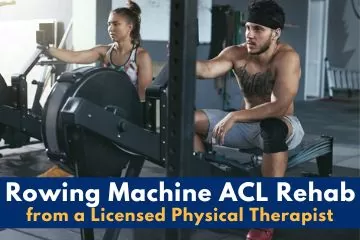
Rehab following an ACL reconstruction is a lengthy process, taking 8-12 months for most. To ensure your full recovery and safe return to sports, your ACL rehabilitation must be directed by a surgeon along with a physical therapist or athletic trainer.
The information I’m going to give you today is based on the American Academy of Orthopedic Surgeons Anterior Cruciate Ligament Guidelines for Clinical Practice, Physical Therapy guidelines from the Journal of Orthopedic and Sports Physical Therapy, and review of several Physicians ACL Protocols.
Please keep in mind that this article is for educational purposes only and not intended to replace the advice and recommendations of your surgeon or physical therapist.
With that out of the way, let me help you find answers to some of the most common questions that people ask after their ACL reconstruction.
What Is ACL and What Is ACL Reconstruction?
The ACL, or anterior cruciate ligament, is the most commonly injured ligament in the knee. It is one of four ligaments connecting the femur to the tibia and preventing the tibia from sliding forward along with providing rotational stability.
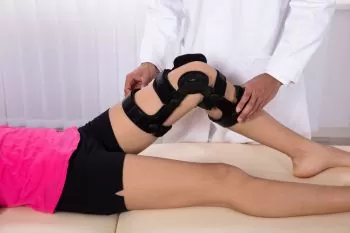
ACL reconstruction is the surgical procedure performed to repair/replace a damaged ACL. After surgery, it will take 8-12 months of ACL rehab to restore the stability and strength of the affected knee.
Is Rowing Good for ACL Rehab?
A closed chain exercise, meaning a weight-bearing activity with a fixed foot position, is recommended following ACL reconstruction. And yes, rowing can be a safe and beneficial component of an ACL rehab program because rowing is a low-impact closed chain exercise that is easy on the knee and other joints.
Early on in the rehab process, light/easy rowing promotes increased knee flexion (bending) range of motion (ROM), working towards regaining normal motion.

As rehab progresses, working out on a rowing machine helps not only in building lower extremity (LE) strength and endurance but also for overall conditioning/endurance.
How Long After ACL Surgery Can You Start Rowing?
When to start rowing machine ACL rehab following surgery should always be cleared with the surgeon because there is some variation between physician protocols.
Besides that, it also varies between patients, depending on what procedure was done (patellar tendon graft vs. hamstring graft) and what other structures were involved (meniscus, additional torn ligaments).
Generally, it is safe to begin rowing on an indoor rowing machine around 4 weeks post op. There may be ROM limits and a brace that restricts bending during this phase, but rowing can easily be modified to work within these limits.
What Is the Recommended Rowing Intensity & Duration for ACL Rehab?
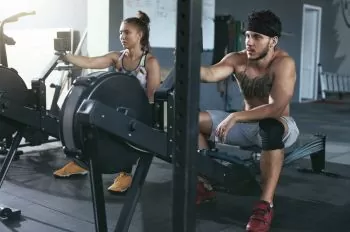
Rowing at this time should be a light easy row, with a low damper setting focusing on proper form, initially limiting knee bend to 30 degrees and gently increasing knee ROM. Rowing would be limited to partial slide, meaning you would not achieve a full catch position.
TIP: To limit your ROM to a safe amount, determine how far up the slide you should be going then mark it with a piece of tape or rubber band. As you slide forward the marker will stop the seat from going too far up into the catch.
Pressure should be light and easy with a low stroke rate (14-18) and no intensity goals (split time significantly higher than your normal).
Five minutes of rowing is usually sufficient to work on ROM and muscle activation without overdoing things because you don’t want pain or swelling to flare up. Take necessary precautions to avoid aggressively forcing the bending of the knee.
TIP: For a good “easy row” workout, switch your machine over to watts instead of split time to measure your power. Keeping your watts equivalent to only 10% of your body weight for your early rows will ensure you are not overdoing it. You can then gradually build from there.
In the 6-10 week post op range, you can begin a gradual progression of increasing intensity and time while continuing to work towards a full catch position. Intervals of pressure on/off may be beneficial in building up muscle strength and endurance as well as overall conditioning.
What Kind of Cardio Can I Do After ACL Surgery?
Due to differences in physician protocols and specific patient conditions, I recommend that you get specific guidance/clearance from your physician or PT before progressing with cardio conditioning/endurance training.
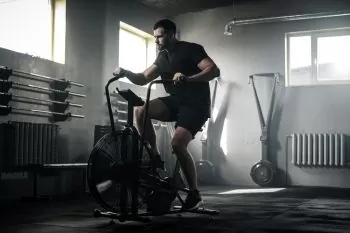
The following are general guidelines that you should always remember as you go through your rehab.
- As early as knee ROM allows, (usually 4-6 weeks), you can start using a stationary bike for cardiovascular conditioning.
- Indoor rower/erg, elliptical trainer, and stairmaster are typically safe to begin in the 6-8 week post op range for cardio conditioning, beginning with low intensity/duration and gradually building. By 9-10 weeks post op, your intensity and duration should have increased for improved endurance.
- Refer to your PT for the right equipment to use for your specific stage of ACL rehab. For example, exercising from a recumbent elliptical cross trainer like the Teeter Freestep ( see our best elliptical rowing machines ) will not only help restore strength and functionality of your affected knee but also allow you to do so while comfortably seated. With the “arms only” option, you can exercise your upper body until such time that your legs are strong enough for a full-body exercise.
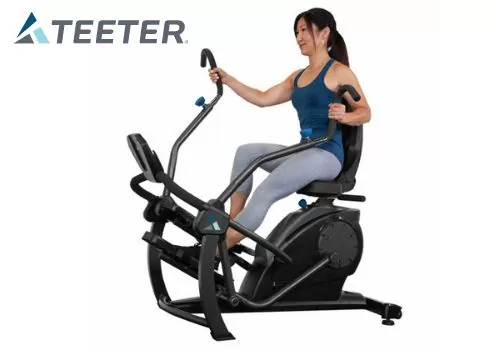
- You can initiate swimming in the 4-8 week range with flutter kicks/freestyle or kick board as long as incision sites have sufficiently healed.
- A supervised running program with walk/run intervals is usually initiated in the 12-14 week range once other criteria have been met and cleared by the physician.
Learn from Olympic Rower Rachael Taylor as She Tries the Teeter FreeStep Elliptical Trainer:
What Should Be Avoided During ACL Rehab?
The things that you should avoid post-surgery differs depending on the graft/type of reconstruction and other structures involved. The rule of thumb is always to take heed of your doctor’s and PT’s orders, but generally, you should avoid the following.
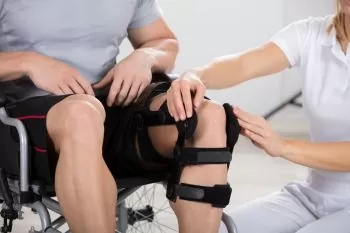
- Take note that early on, full knee straightening is desired, so you should avoid propping something under the knee for comfort.
- You should not unlock or go without a brace when walking unless advised to do so by your physician or physical therapist. Good activation of the quadricep muscle is critical to avoid buckling. Avoid walking on a bent knee and remember to always straighten the knee when walking.
- Avoid forceful/aggressive bending of the knee in the first 6 weeks.
- No hamstring strengthening is permitted (typically for the first 6 weeks) following a hamstring graft.
- Early on, no resisted open kinetic chain exercises are permitted. In open chain exercises, the knee is flexed while the foot is moving, such as when you kick a ball or work out on a leg extension machine at the gym.
- No turning, pivoting, twisting or lateral movements for 3 months to build adequate strength and allow healing of the graft. Important: The 6-12 week range is when the graft is most delicate and at risk for re-injury.
- No jumping, cutting, pivoting, running until cleared by your physician/physical therapist.
What Exercise Can I Do with Torn ACL That Is Not Being Repaired?
There are cases when physicians decide that reconstruction of an ACL injury/tear is not necessary. Partial tears respond well to rest and usually have a favorable outcome in 3 months. In fact, complete tears with minimal or no knee instability in a fairly inactive individual can function with an ACL-deficient knee.
That said, it’s important to know that rehabilitating an ACL-deficient knee must be strictly supervised by a physical therapist. The rehab involves building the ROM, strength, and stability of an ACL-deficient knee to ensure safe return to activity.
Generally, the exercises that you can do include the following:
- Initial exercises focus on gently improving knee range of motion and quadricep activation.
- Once pain subsides and ROM improves, you can begin some cardio using the rowing machine and stationary bike. These activities limit load bearing and do not involve any pivoting or twisting motions. Workouts begin at a low intensity for a short period, gradually building on both intensity and time as you progress.
- As time and healing progresses, you can add swimming and elliptical to build strength and improve cardio. Begin at low intensity for a short period and building gradually.
Overall, strengthening, proprioceptive and balance exercises will help you improve knee stability.
Bottom Line
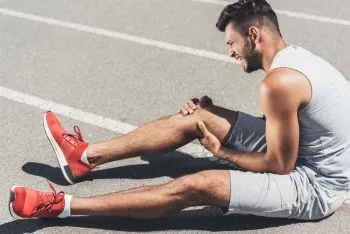
If you’ve torn an ACL, whether it’s complete or partial, and whether you’ve had ACL reconstruction or opted for ACL-deficient (non-surgical) knee rehab, there’s one thing to remember. Your rehabilitation program must be cleared with your physician and supervised by your physical therapist or athletic trainer.
Restoring your knee’s strength and functionality will take at least 8-12 months. However, physician protocols and patient conditions depend of many variables, so expect your specific rehab approach to differ.
If you used to row before your ACL was damaged and are starting to miss your rowing workouts, here’s good news for you. Rowing exercises can be safely integrated into your ACL rehab program. Generally, however, you should start with rowing movements that are easy on your knees.
Always consult your physical therapist, and you’ll be fine and rowing back again in no time!
Written by Laura Tanley – RowingCrazy.com
Certified Indoor Rowing & Erg Instructor (UCanRow2), Experienced Indoor & On-the-Water Rower & Licensed Physical Therapist
Laura is a mother of two, Certified Indoor Rowing Instructor, Licensed Physical Therapist with concentration in Orthopedics and Vestibular Rehab. Laura has years of rowing experience both indoor and on the water. She is excited to join to share her knowledge with the indoor rowing community.



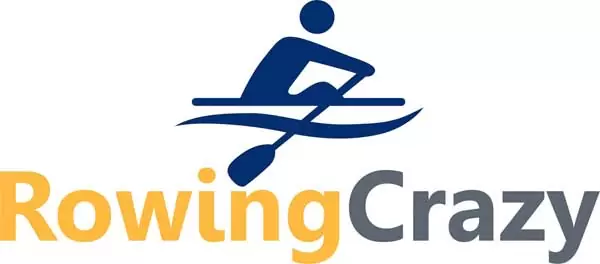


Pingback: Are Rowing Machines Good for Bad Knees? | Rowing Crazy
Pingback: Best Exercise for Bad Knees to Lose Weight Fast & Pain-Free!